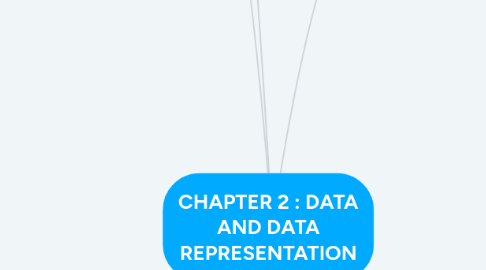
1. NUMBERING SYSTEM
1.1. NUMBER BASES
1.1.1. RADIX
1.1.1.1. When referring to binary, octal, decimal, hexadecimal, a single lowercase letter appended to the end of each number to identify its type
1.1.1.2. Example :
1.1.1.2.1. Hexadecimal 45 will be written as 45h
1.1.1.2.2. Binary 11010011 will be written as 11010011b
1.1.1.2.3. Binary 11010011 will be written as 11010011b
1.1.2. BASE
1.1.2.1. The number of different symbols required to represent any given number
1.1.2.2. The larger the base, the more numerals are required
1.1.3. BINARY SYSTEM
1.1.3.1. Early computer design was decimal
1.1.3.2. Mark I and ENIAC
1.1.3.3. John Von Neumann proposed binary data processing (1945)
1.1.3.4. Simplified computer design
1.1.3.5. Used for both instructions and data
1.1.3.6. Natural relationship between on/off switches and calculations using boolean logic
1.1.3.7. A base 2 numbering system
1.1.4. OCTAL SYSTEM
1.1.4.1. As known as base 8 numbering system
1.1.4.2. Only eight different digits are available (0,1,2,3,4,5,6,7)
1.1.5. DECIMAL SYSTEM
1.1.5.1. A base 10 numbering system
1.1.5.2. Use a system based on decimal digirs to represent numbers
1.1.5.3. Each digit multiplid by 10 raised to apower corresponding to that digit position
1.1.6. HEXADIECIMAL SYSTEM
1.1.6.1. Base 16 numbering system
1.1.6.2. Used not only to represent integers
1.1.6.3. Also used to represent sequence of binary digits
1.1.6.4. Also used to represent sequence of binary digits
2. BITS, BYTES AND WORDS
2.1. BITS
2.1.1. The basic unit of information in computing and telecommunication
2.1.2. A variable or computed quantity that can have two possibles
2.1.3. These two values are often intepreted as binary digits and are ususally denoted by 0 and 1
2.2. BYTES
2.2.1. A unit of digital informations in computing and telecommunications, that most commonly consists of eight bits
2.2.2. The number of bits used to encode a single character of text in a computer and it is for this reason the basic addressable element in many computer architecture
2.3. WORDS
2.3.1. Term for the natural unit of data used by a particular computer design
2.3.2. Simply a fixed sized group of bits that are handled together by the system
2.3.3. The number of bits in a word is an important characteristics of computer architecture
3. ASCII CODES, UNICODE
3.1. THE ALPHANUMERIC REPRESENTATION
3.1.1. The data entered as characters , number digits, and punctuation are known as alphanumeric data
3.1.2. 3 alphanumeric codes
3.1.2.1. ASCII
3.1.2.1.1. Acronym for the American Standard Code for Information Interchange
3.1.2.1.2. The purpose of ASCII was to provide a standard to code various symbols
3.1.2.1.3. Each binary value between 0 and 127 represents a specific character
3.1.2.1.4. The purpose of ASCII was to provide a standard to code various symbols
3.1.2.1.5. Each binary value between 0 and 127 represents a specific characters
3.1.2.2. Unicode
3.1.2.2.1. A worldwide character-encoding standard
3.1.2.2.2. To enable a single, unique character set that is capable supporting all characters from all scripts, as well as symbols, that are commonly utilized for computer processing throughout the globe
3.1.2.2.3. 16-bit standard
3.1.2.2.4. it is a superset of ASCII
3.1.2.2.5. To enable a single, unique character set that is capable supporting all characters from all scripts, as well as symbols, that are commonly utilized for computer processing throughout the globe
3.1.2.3. EBCDIC
3.1.2.3.1. Extended Binary Coded Decimal Interchange Code developed by IBM
4. DATA INFORMATION & PROCESSING
4.1. DATA
4.1.1. MEANING
4.1.1.1. Unprocessed facts or figure
4.1.1.2. Collection of unprocessed item which can include text, numbers, images, audio and video
4.1.2. DATA FORMATS
4.1.2.1. COMPUTERS
4.1.2.1.1. Process and store all forms of data in binary format
4.1.2.2. HUMAN COMMUNICATION
4.1.2.2.1. Includes languages, images amd sound
4.1.2.3. 1. Specifications for converting data into computer-usable form.
4.2. INFORMATION
4.2.1. MEANING
4.3. PROCESSING
4.3.1. DATA CODING
4.3.1.1. MEANING
4.3.1.1.1. Data is encoded by assigning a bit pattern to each character, digit, or multimedia object
4.3.1.2. STANDARD
4.3.1.2.1. Character encoding : ASCII
4.3.1.2.2. Image encoding : JPEG
4.3.1.2.3. Video encoding : MPEG-4
4.3.1.2.4. Image encoding : JPEG
4.3.2. DATA STORAGE AND COMPRESSION
4.3.2.1. MEANING
4.3.2.1.1. Reduce the size of data to save space or transmission time
4.3.2.2. CATEGORIES
4.3.2.2.1. LOSSLESS
4.3.2.2.2. LOSSY
4.3.3. DATA INTEGRITY
4.3.3.1. MEANING
4.3.3.1.1. Security or protection of data
4.3.3.1.2. Protect file from bring read, written to or executed
4.3.3.1.3. example : Password protection and keyboard locking

